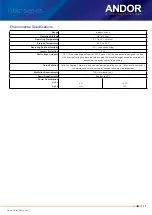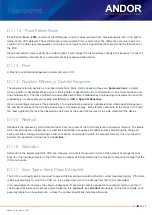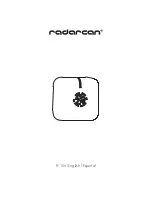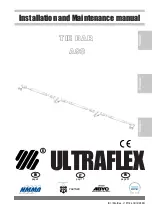
Version 2.0 rev 26 Jan 2017
32
iVac series
D1.1.1 - Readout Sequence of a CCD
In the course of readout, charge is moved vertically into the shift register, and then horizontally from the shift register into
the output node of the amplifier. The readout sequence illustrated below (which corresponds to the default setting of the
Full Resolution Image
binning pattern) allows data to be recorded for each individual element on the CCD-chip. Other
binning patterns are achieved by summing charge in the shift register and/or the output node prior to readout (please
see
Vertical Binning
and
Horizontal Binning
).
1
Exposure to light causes a pattern of charge (an electronic image) to build up on the frame (or ‘image area’) of the CCD-chip.
2
Charge in the frame is shifted vertically by one row, so that the bottom row of charge moves into the shift register.
3
Charge in the shift register is moved horizontally by one pixel, so that charge on the endmost pixel of the shift register is moved into the output
node of the amplifier.
4
The charge in the output node of the amplifier is passed to the analog-to-digital converter and is read out.
5
Steps 3 & 4
are repeated until the shift register is emptied of charge.
6
The frame is shifted vertically again, so that the next row of charge moves down into the shift register. The process is repeated from Step 3 until
the whole frame is read out.
D1.2 - Accumulation
Accumulation is the process by which data that have been acquired from a number of similar scans are added together
in computer memory. This results in improved signal to noise ratio.
D1.3 - Acquisition
An Acquisition is taken to be the complete data capture process.
D1.4 - A/D Conversion
Charge from the CCD is initially read as an analog signal, ranging from zero to the saturation value.
A/D
(
A
nalog to
D
igital) conversion changes the analog signal to a binary number which can then be manipulated by the computer.









































